Tennessee’s landscapes face relentless pressure from invasive species… plants, insects, and animals that disrupt native ecosystems and cause millions in economic damage.
From aggressive vines choking forests to pests destroying crops and wildlife, these invaders change the way nature and communities thrive.
Understanding the most common and harmful invasive species is key to protecting Tennessee’s natural beauty and resources for future generations. Let’s dig in!
Aquatic Species
Silver Carp (Hypophthalmichthys molitrix)
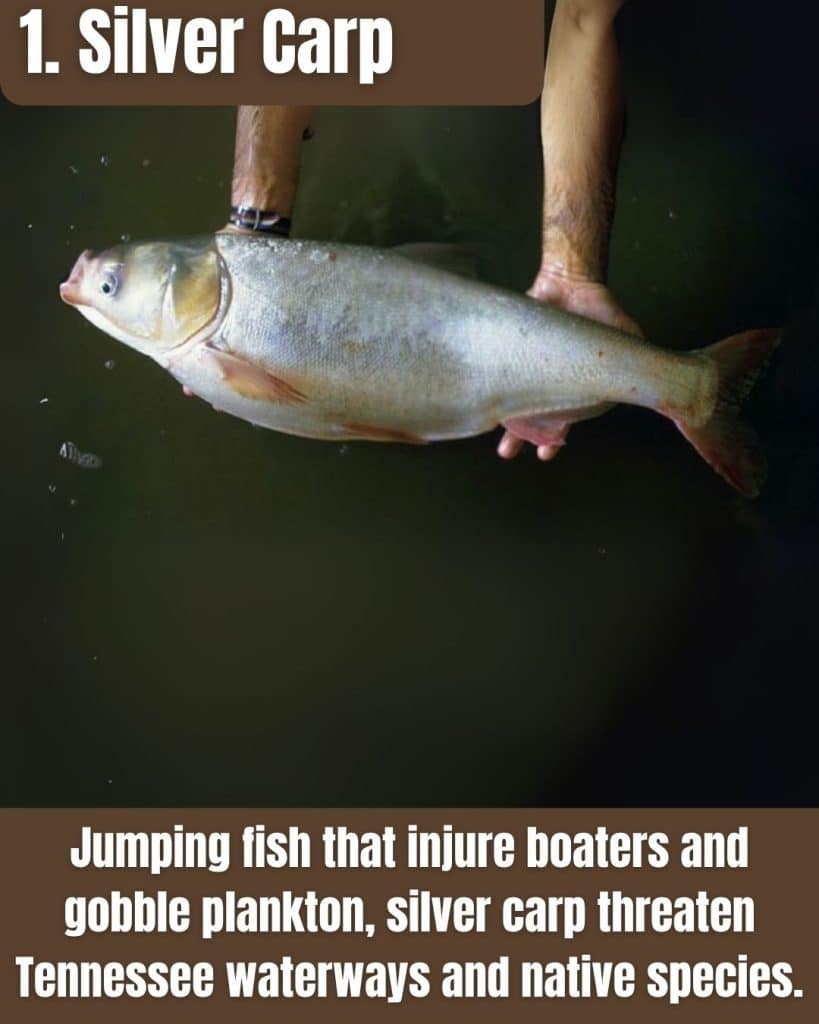
- Eats large amounts of plankton, starving native fish.
- Famous for leaping out of water, sometimes injuring boaters.
- Rapidly multiplies and dominates local waterways.
Silver carp are invasive Asian fish causing serious problems in Tennessee’s waterways.
These large plankton-feeders outcompete local fish by consuming massive amounts of phytoplankton.
Their explosive growth disrupts the food chain, reducing native fish numbers and damaging the local fishing economy.
Zebra Mussel (Dreissena polymorph)
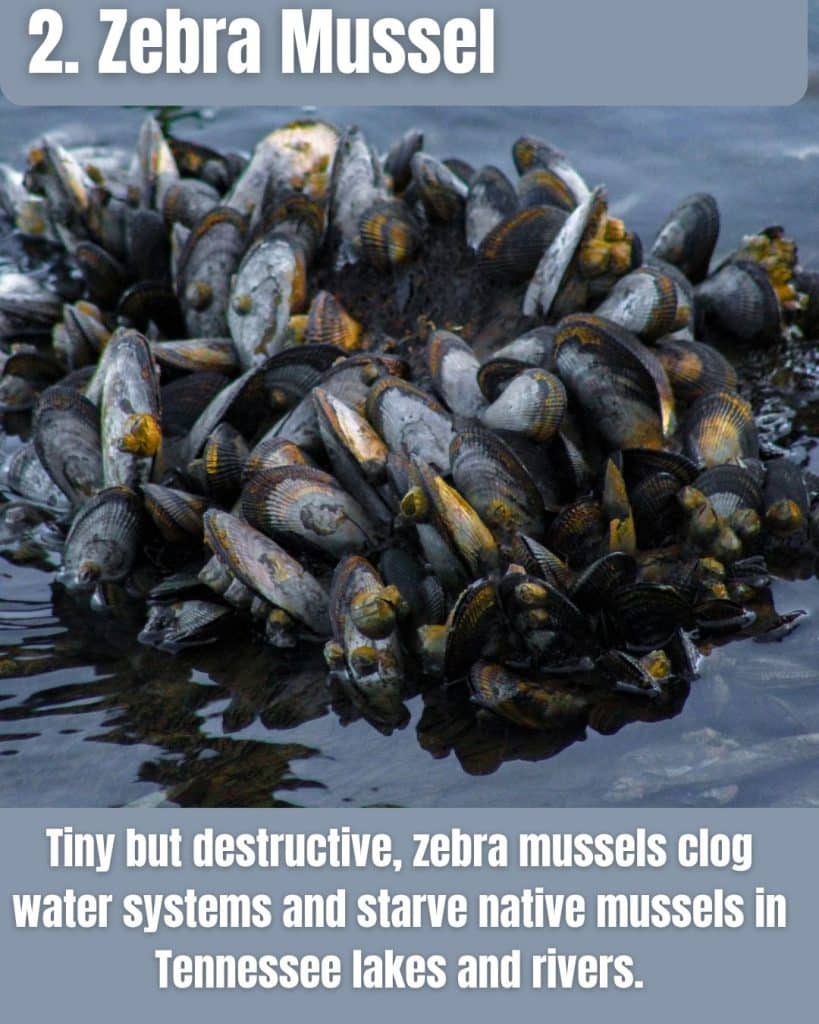
- Attaches densely to pipes, boats, and docks.
- Filters plankton, reducing food for native species.
- Smothers native mussels, causing population declines.
The zebra mussel, originally from Eurasia, has aggressively invaded Tennessee’s freshwater ecosystems.
Their infestations lead to significant ecological damage, including major declines in native mussel populations.
Additionally, zebra mussels cause expensive damage to infrastructure such as municipal water systems and power plants, resulting in costly cleanup efforts.
Hydrilla (Hydrilla verticillata)
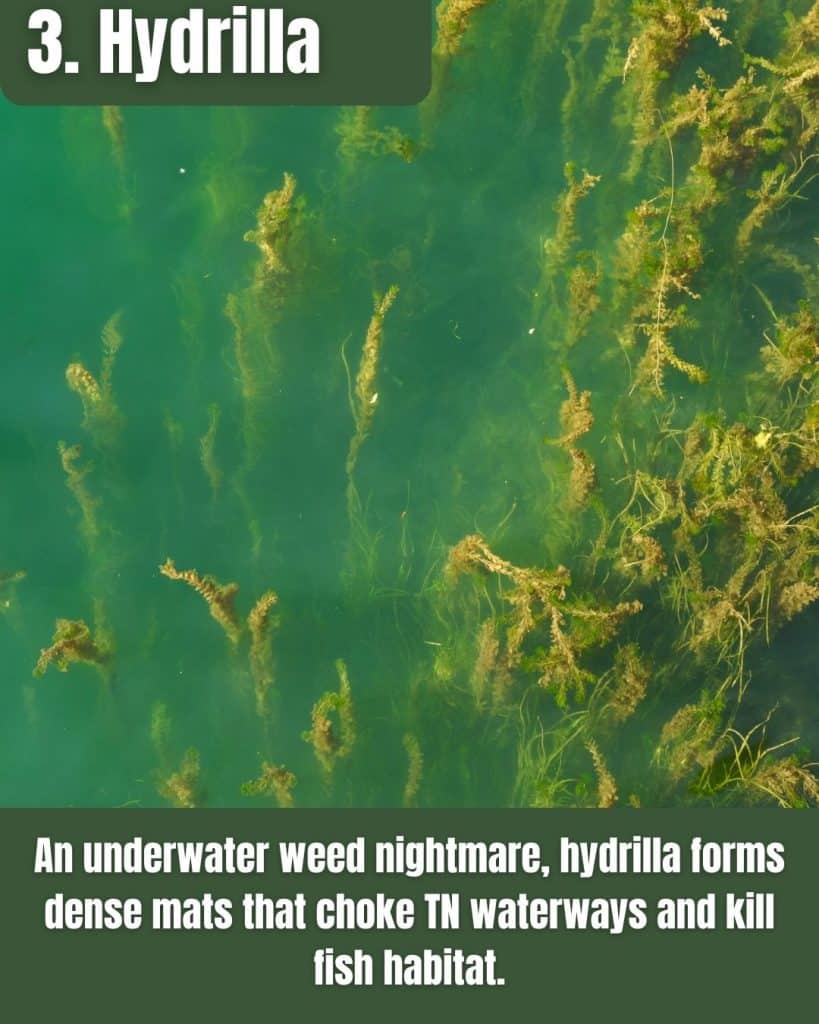
- Forms dense underwater mats, blocking sunlight.
- Reduces oxygen in water, harming fish.
- Clutters waterways, interfering with boats and recreation.
Hydrilla, known as “water thyme,” is an invasive aquatic plant rapidly spreading through Tennessee’s waters.
It aggressively outcompetes native plants, altering habitats essential for fish and waterfowl. Infestations make fishing, boating, and swimming difficult, negatively affecting recreation and tourism.
Controlling hydrilla is costly and challenging for lake managers.
Bighead Carp (Hypophthalmichthys nobilis)
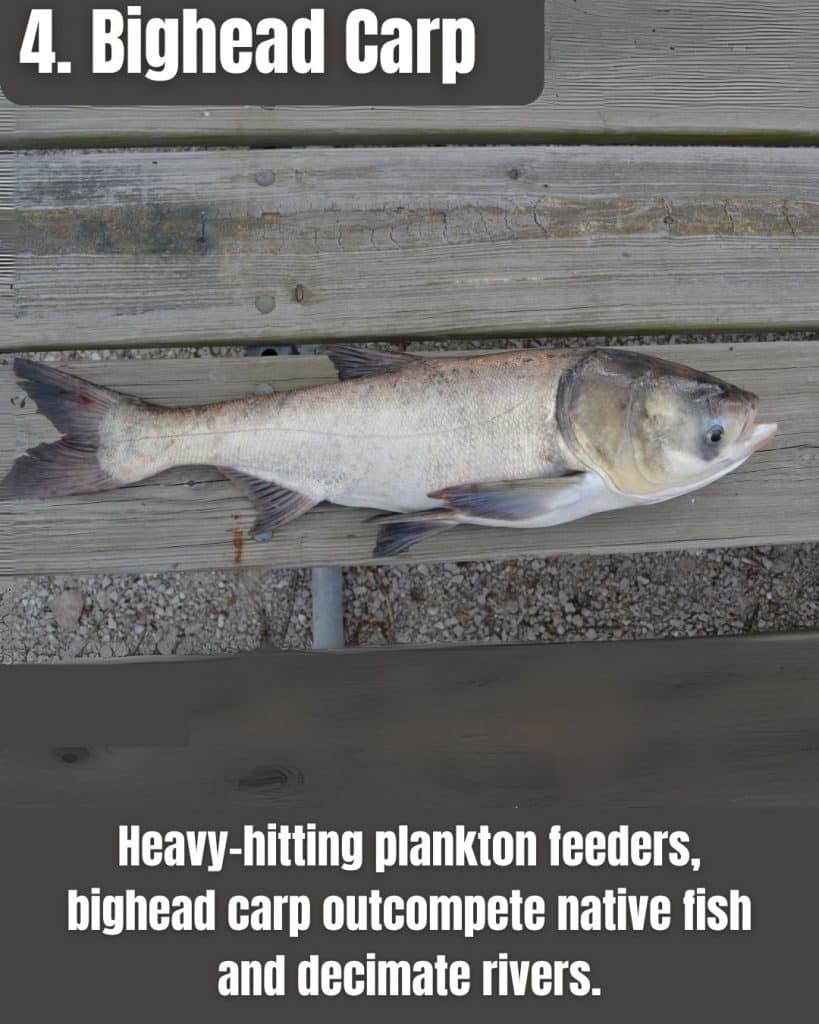
- Introduced to control algae but became invasive.
- Eats zooplankton, depriving native fish larvae of food.
- Reproduces rapidly without natural predators.
Bighead carp are invasive Asian fish introduced to Tennessee waters for algae control. T
heir heavy consumption of zooplankton disrupts the food supply for native fish larvae, which starves out the native fish.
With no natural predators to limit their growth, bighead carp rapidly dominate ecosystems, negatively affecting commercial and recreational fishing.
New Zealand Mudsnail (Potamopyrgus antipodarum)
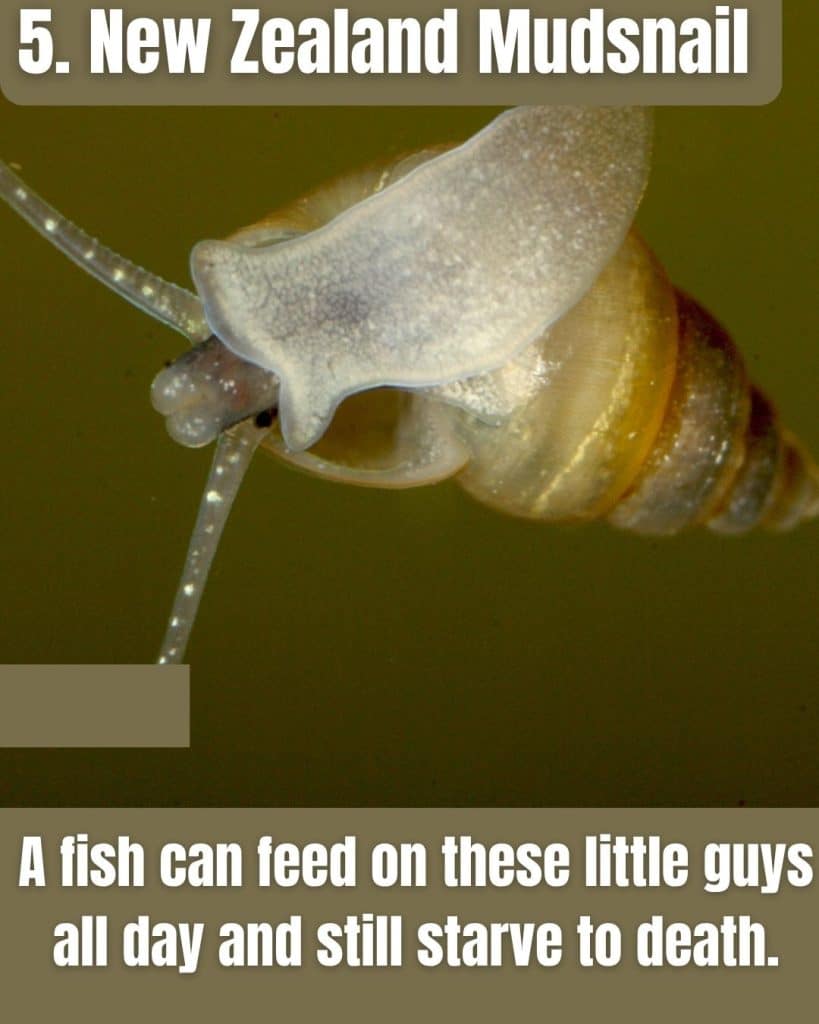
- Tiny snail reproducing rapidly through cloning.
- Competes directly with native snails and aquatic insects.
- Provides minimal nutrition to fish, passing through their guts alive.
The tiny New Zealand mudsnail multiplies quickly in Tennessee streams, altering food webs and outcompeting native species.
Their high densities reduce food availability for fish and aquatic insects. Mudsnails easily spread on fishing gear, complicating management efforts.
Birds
House Sparrow (Passer domesticus)
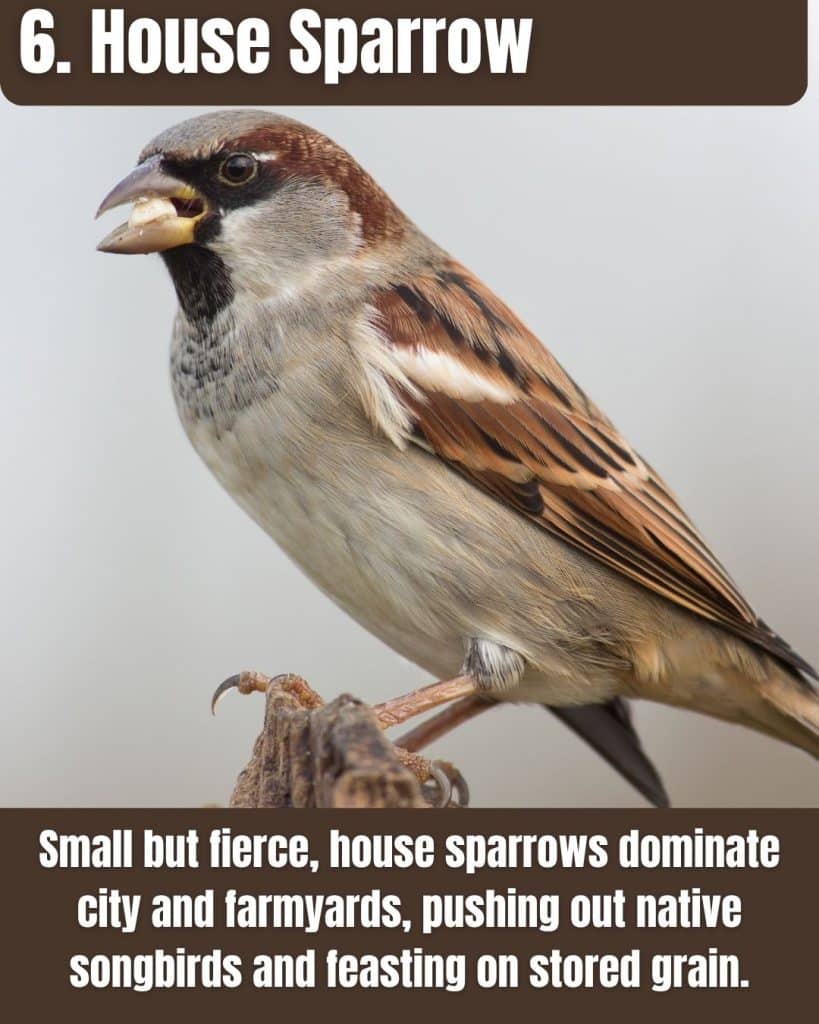
- Aggressively competes with native birds for nesting sites.
- Breeds multiple times per year, rapidly increasing populations.
- Considered a pest in urban and agricultural settings.
The house sparrow is an invasive bird, widespread in Tennessee’s towns and farmlands. Originally from Eurasia, it arrived in North America during the 19th century and quickly became abundant.
It aggressively displaces native species such as bluebirds and swallows, often harming their eggs and nestlings.
Thriving around human settlements, house sparrows harm Tennessee’s native bird populations.
European Starling (Sturnus vulgaris)
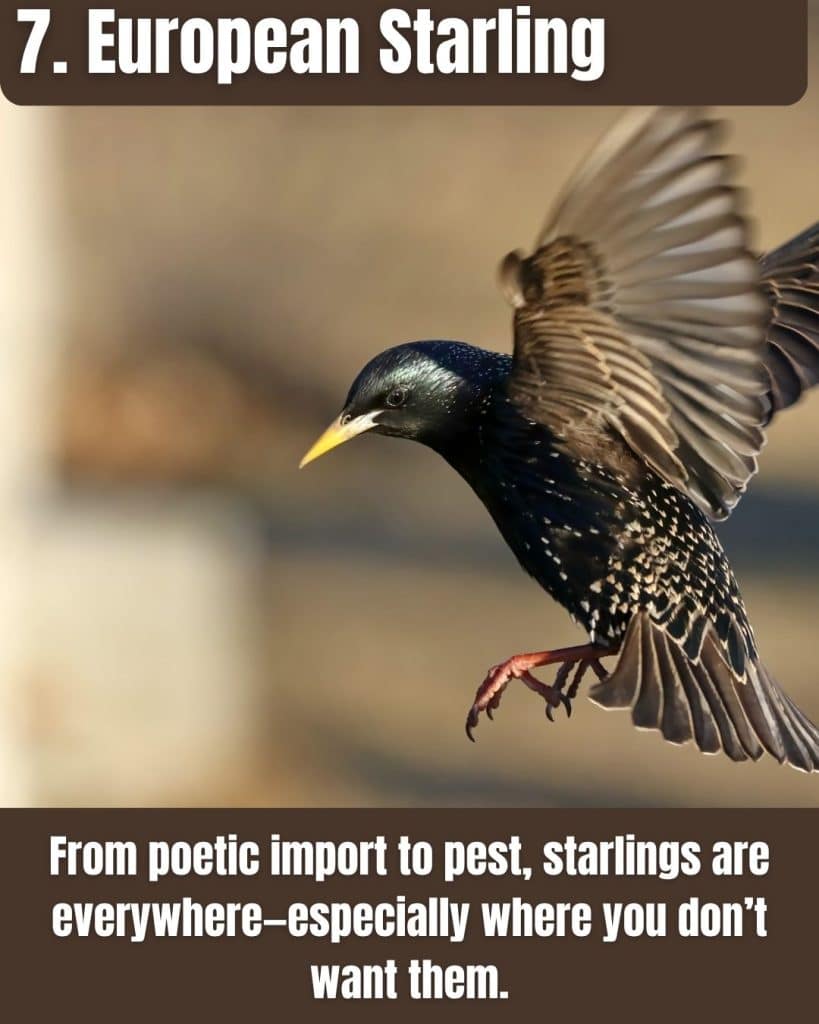
- Introduced from Europe; now widespread in Tennessee.
- Aggressively displaces native cavity-nesting birds.
- Causes agricultural damage and health concerns with large flocks.
The European starling, introduced to North America in 1890, has become very common across Tennessee.
These adaptable black birds with speckles form large flocks and compete fiercely for nesting sites, pushing out native birds like woodpeckers and bluebirds.
They feed on diverse foods and often damage crops by feeding in large numbers on farms.
Their massive roosts can create health hazards and foul surfaces with droppings, impacting native bird populations and increasing costs for farmers and communities.
Rock Pigeon (Columba livia)
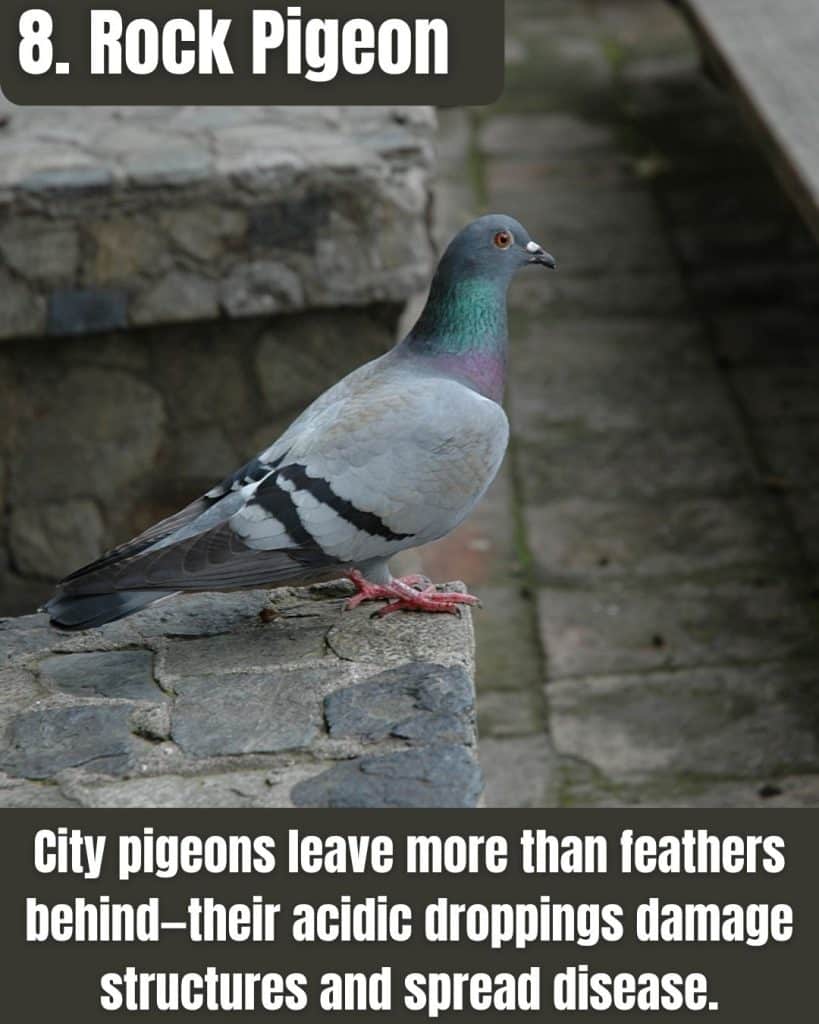
- Common gray pigeon in Tennessee’s cities, originally domesticated in Europe.
- Causes property damage with acidic droppings.
- Can carry diseases harmful to humans.
The rock pigeon, often just called “pigeon,” is a familiar urban bird in Tennessee. Though not a major threat to native birds, feral populations create problems by defacing buildings, statues, and sidewalks with corrosive droppings.
Nesting pigeons clog gutters and ventilation, while their droppings and feathers may carry diseases like histoplasmosis.
Managing these birds and cleaning up their mess is a costly, ongoing issue in Tennessee cities.
Eurasian Collared-Dove (Streptopelia decaocto)
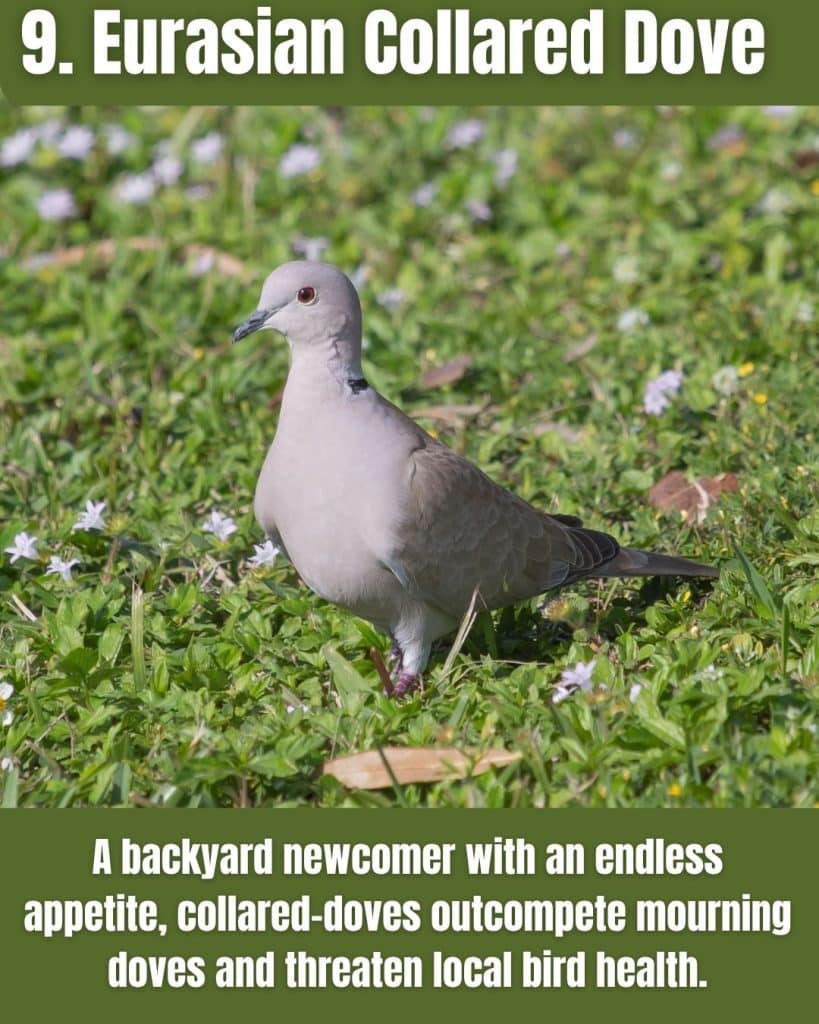
- Pale gray dove with a distinctive black collar on its neck.
- Rapidly spread across Tennessee since the 1990s.
- Competes with native mourning doves and may carry diseases.
The Eurasian collared-dove arrived in the U.S. after escaping pets established a population in the Bahamas in the 1970s.
Since then, it has quickly spread throughout Tennessee’s suburban and rural areas, thriving near people at feeders and power lines.
Their growing numbers compete with native mourning doves for food and nesting sites and pose risks by carrying diseases.
This invasive dove is really becoming a concern for native bird populations and agriculture.
Mute Swan (Cygnus color)
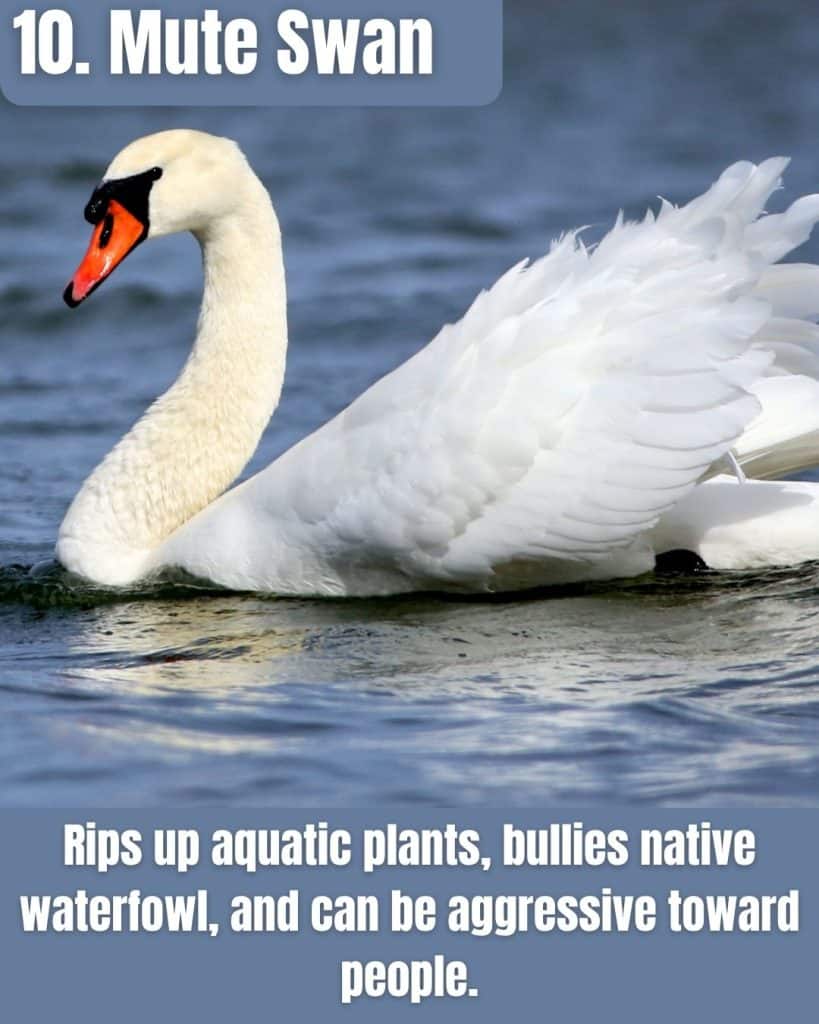
- Large white swan introduced from Europe with an orange bill.
- Eats up to 8 pounds of aquatic plants daily, damaging wetlands.
- Highly territorial and aggressive toward native waterfowl and people.
Mute swans in Tennessee are non-native birds that escaped or were released from private collections.
They consume vast amounts of aquatic vegetation, harming wetlands and removing habitat for native fish, frogs, and waterfowl.
Their aggressive nature displaces native ducks and geese, and they can even attack humans near their nests.
Though still rare, mute swan populations raise concerns for ecosystem health and native wildlife.
Animals (Mammals and Reptiles)
Feral Hog [Wild Boar] (Sus scrofa)
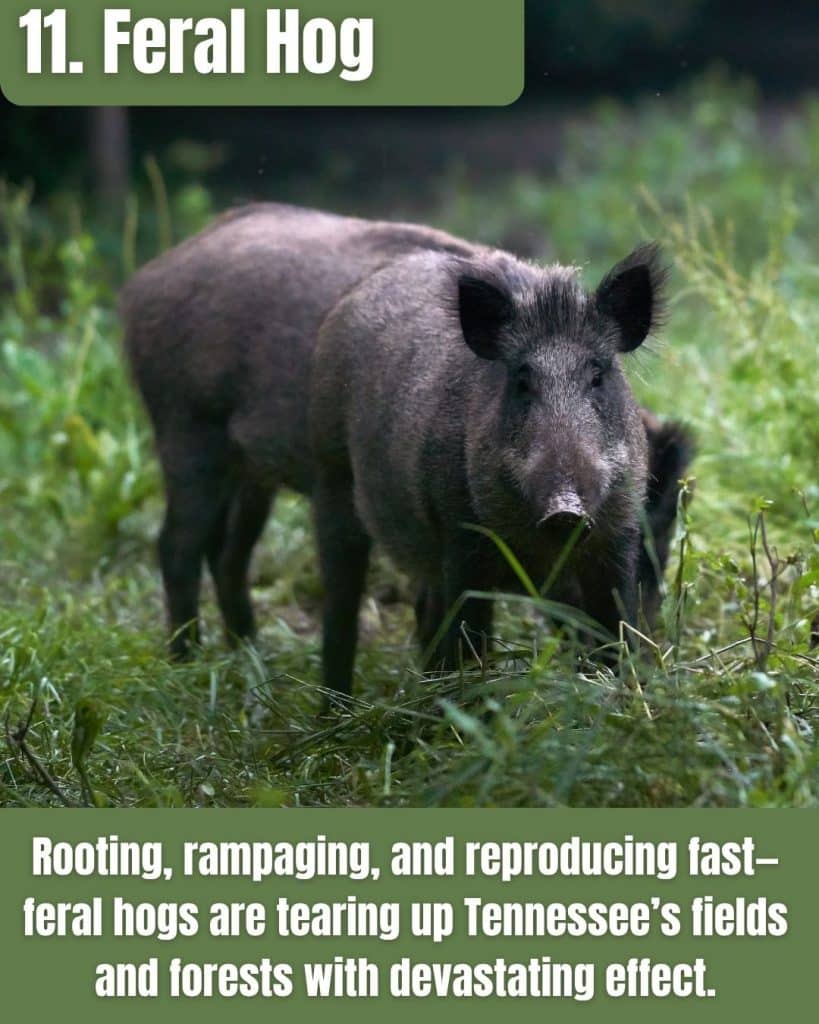
- Descendants of escaped domestic pigs and imported wild boars.
- Root up soil, causing erosion and destroying native plants.
- Damage crops, prey on wildlife, and spread diseases to livestock.
Feral hogs are highly destructive invasive animals in Tennessee. With few natural predators, their populations have surged.
Their rooting behavior disrupts soil and forests, harming native plants and tree regeneration. On farms, they damage crops and fences.
They also prey on ground-nesting wildlife and compete with native animals for food.
Due to their aggression and wide-ranging damage, Tennessee actively works to control feral hog populations.
Nutria (Myocastor coypus)
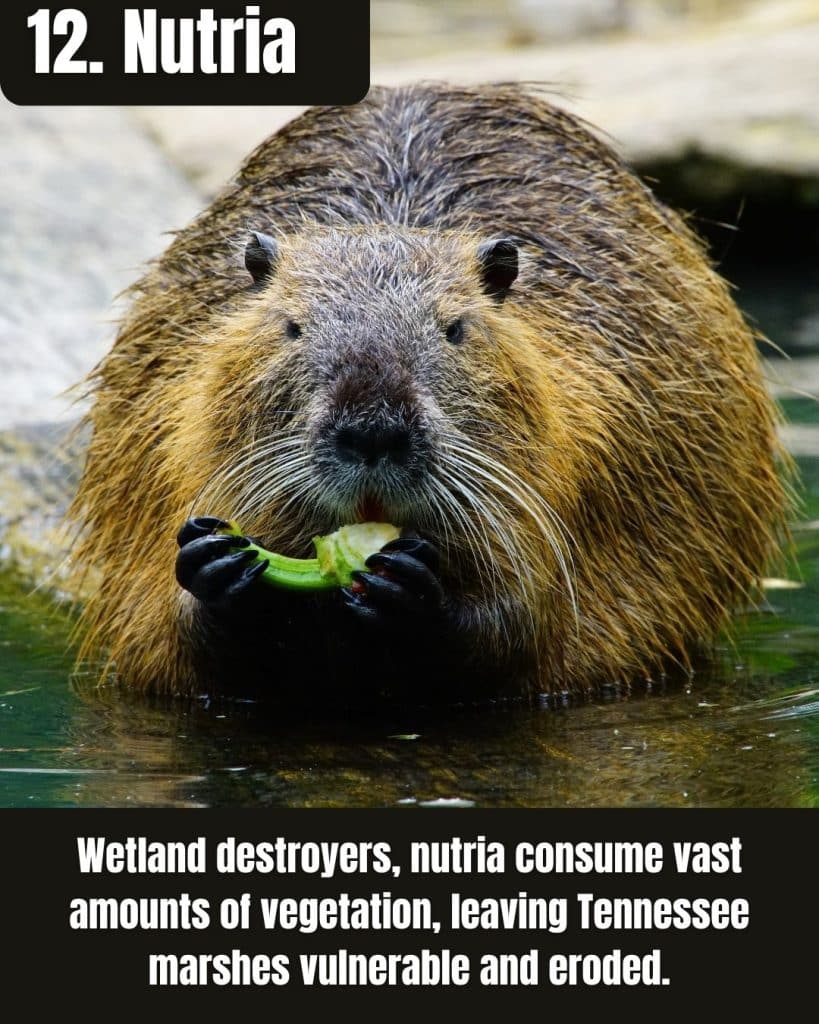
- Large semi-aquatic rodent native to South America.
- Destroys wetlands by overfeeding on aquatic plants.
- Burrows weaken flood-control structures, increasing risks.
Nutria, introduced for the fur trade, have become invasive in Tennessee’s wetlands. They rapidly consume aquatic vegetation, leading to erosion and loss of habitat for native fish and birds.
Their burrowing damages levees and pond banks, raising flood risks and maintenance costs. Nutria also harm crops near water by feeding on or trampling young plants.
Their impact forces wildlife agencies to invest in costly removal efforts to protect ecosystems and agriculture.
Feral Cat (Felis catus)
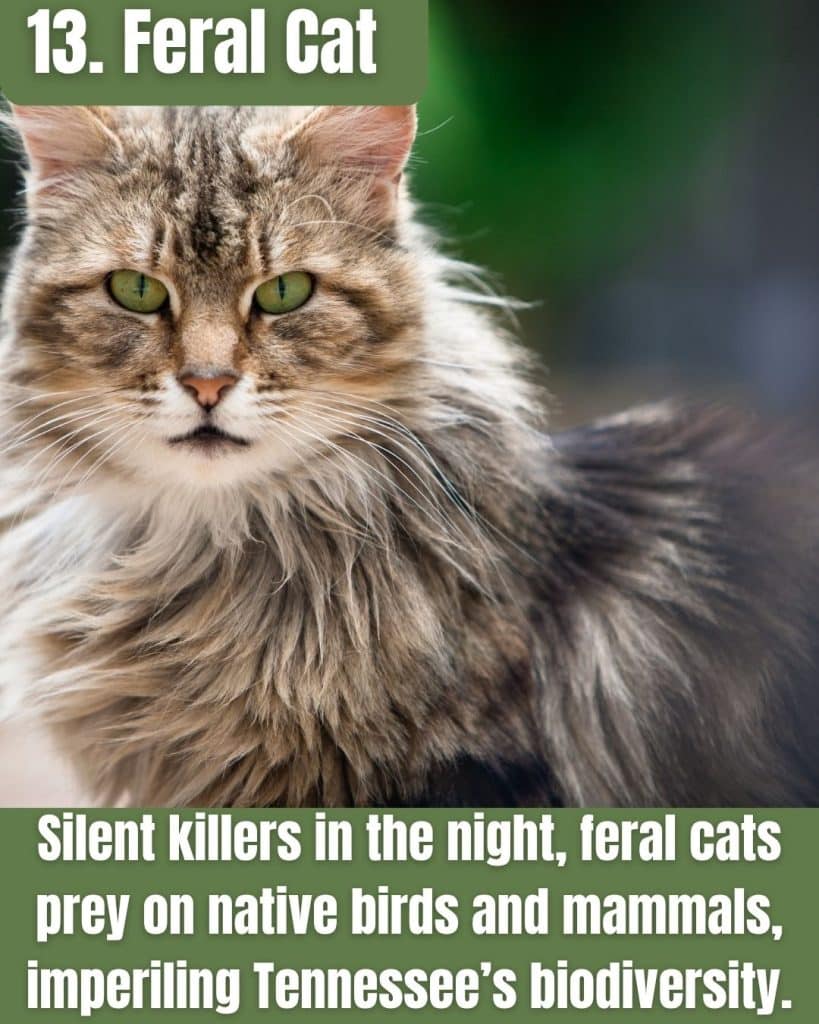
- Abandoned or wild domestic cats living and breeding outdoors.
- Prey heavily on native birds, mammals, reptiles, and amphibians.
- Can spread diseases and create nuisances near homes.
Feral cats in Tennessee thrive year-round due to the mild climate. These skilled hunters drastically reduce populations of native wildlife, including birds and small mammals.
They also carry diseases like toxoplasmosis and rabies, which can affect humans and animals. Feral cat populations near homes cause noise, odors, and flea problems.
To protect native species, Tennessee encourages spaying/neutering and keeping pet cats indoors.
Norway Rat (Brown Rat) (Rattus norvegicus)
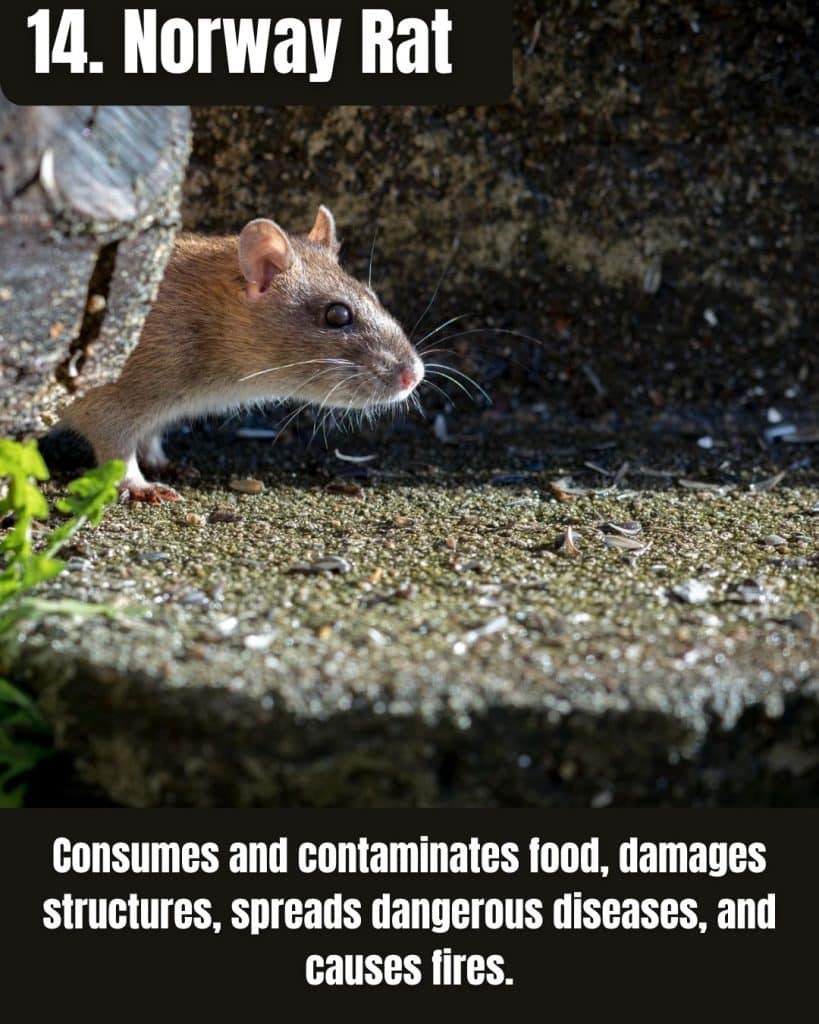
- Adaptable rodent originally from Asia, common in Tennessee urban and rural areas.
- Causes economic losses by contaminating food and damaging structures.
- Carries diseases harmful to humans and livestock.
The Norway rat, also known as the brown rat, thrives in Tennessee’s cities, farms, and wild areas.
It contaminates food supplies and damages buildings by gnawing on wood, wires, and pipes.
These rats prey on eggs and young wildlife, pressuring native species. Known disease carriers, they spread salmonella, leptospirosis, and more.
Their rapid reproduction makes infestations costly to manage, posing serious ecological and economic threats.
Nine-Banded Armadillo (Dasypus novemcinctus)
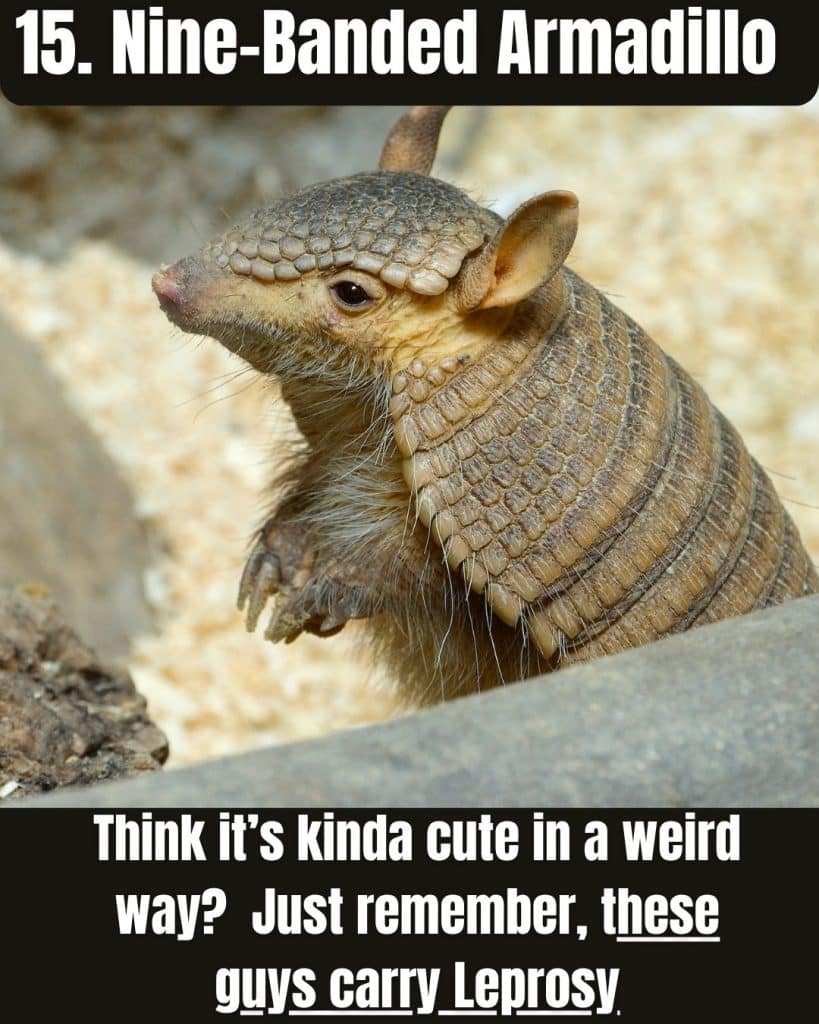
- Native to Central and South America, recently spreading into Tennessee.
- Disrupts lawns and habitats by digging for insects and earthworms.
- Can carry bacteria that cause leprosy, posing a rare health risk.
The nine-banded armadillo has expanded into Tennessee due to warming climates and few predators.
Known for its armored shell and digging, it damages lawns, gardens, and natural areas by uprooting plants and disturbing nests.
While leprosy transmission to humans is rare, the bacteria they carry remain a health concern. This invasive species causes both ecological disruption and nuisance problems as it spreads.
Plants
Kudzu (Pueraria Montana)
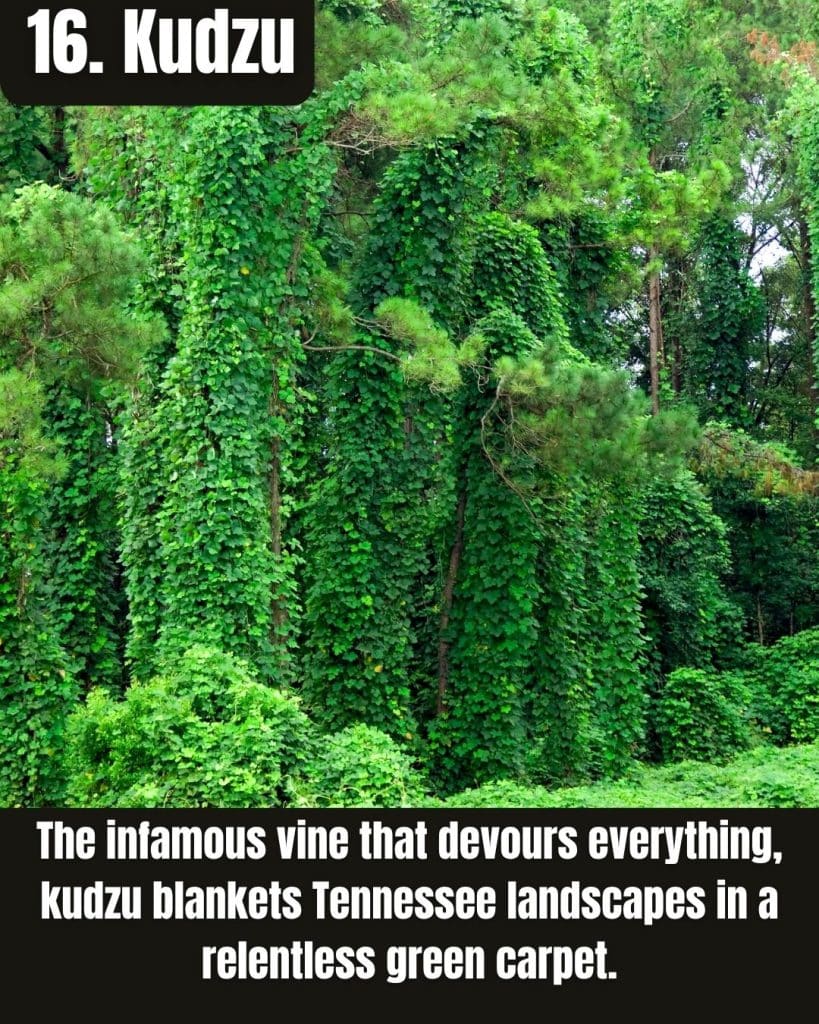
- Nicknamed “the vine that ate the South” for rapid growth.
- Smothers native trees and plants by blocking sunlight.
- Damages infrastructure and reduces forest biodiversity.
Kudzu, native to Asia, was introduced to Tennessee for erosion control but quickly became invasive. It grows up to a foot per day, covering hillsides, trees, and structures.
By smothering native vegetation, kudzu creates monocultures that slash biodiversity and reduce timber production.
It also harms infrastructure like power lines. Managing kudzu requires ongoing cutting and herbicide use, making it one of Tennessee’s most notorious invasive plants.
Chinese Privet (Ligustrum sinense)
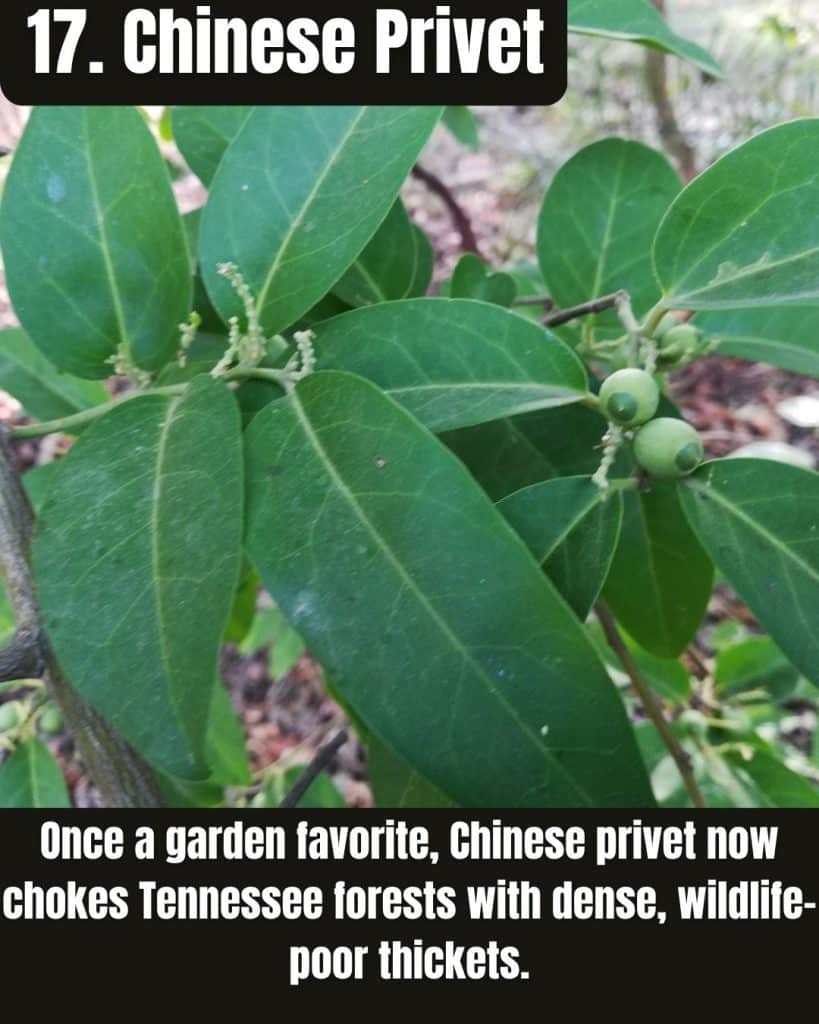
- Invasive shrub escaping cultivation, forming dense thickets.
- Crowds out native plants, reducing biodiversity and wildlife habitat.
- Difficult and costly to remove from forests and farmland.
Chinese privet, once used as a hedge, now infests Tennessee’s forests, streams, and roadsides.
Its thick, semi-evergreen growth shades out native trees and wildflowers, replacing diverse plant life with nearly pure privet stands.
Along streams, it alters erosion and harms habitats. Privet spreads quickly through bird-dispersed seeds and invades pastures, causing problems for farmers. Controlling it requires intensive labor and herbicide use.
Amur Honeysuckle (Lonicera maackii)

- Early leafing and late leaf drop extend its growing season.
- Forms dense shrubs that block native tree seedlings.
- Produces berries that spread widely but offer poor nutrition.
Amur honeysuckle, native to East Asia, invades Tennessee’s forests and fields after being introduced as an ornamental.
Its long growing season and rapid growth create thick shrub layers that prevent native trees and wildflowers from growing.
This reduces plant diversity and food sources for wildlife, including birds that eat its less nutritious berries.
Controlling Amur honeysuckle requires ongoing cutting efforts to protect habitats and biodiversity.
Autumn Olive (Elaeagnus umbellata)

- Rapid grower that thrives on poor, disturbed soils.
- Fixes nitrogen, altering soil chemistry and aiding other invasives.
- Forms dense thickets that outcompete native plants and reduce habitat.
Autumn olive, native to Asia, spreads in Tennessee through birds that eat its berries. It invades fields, grasslands, and forest edges, creating thick, impenetrable thickets.
By changing soil nitrogen levels, it disrupts native plant communities and reduces habitat for pollinators and wildlife.
Its tough nature and resprouting ability make removal costly and challenging, solidifying its status as a major invasive species.
Tree-of-Heaven (Ailanthus altissima)
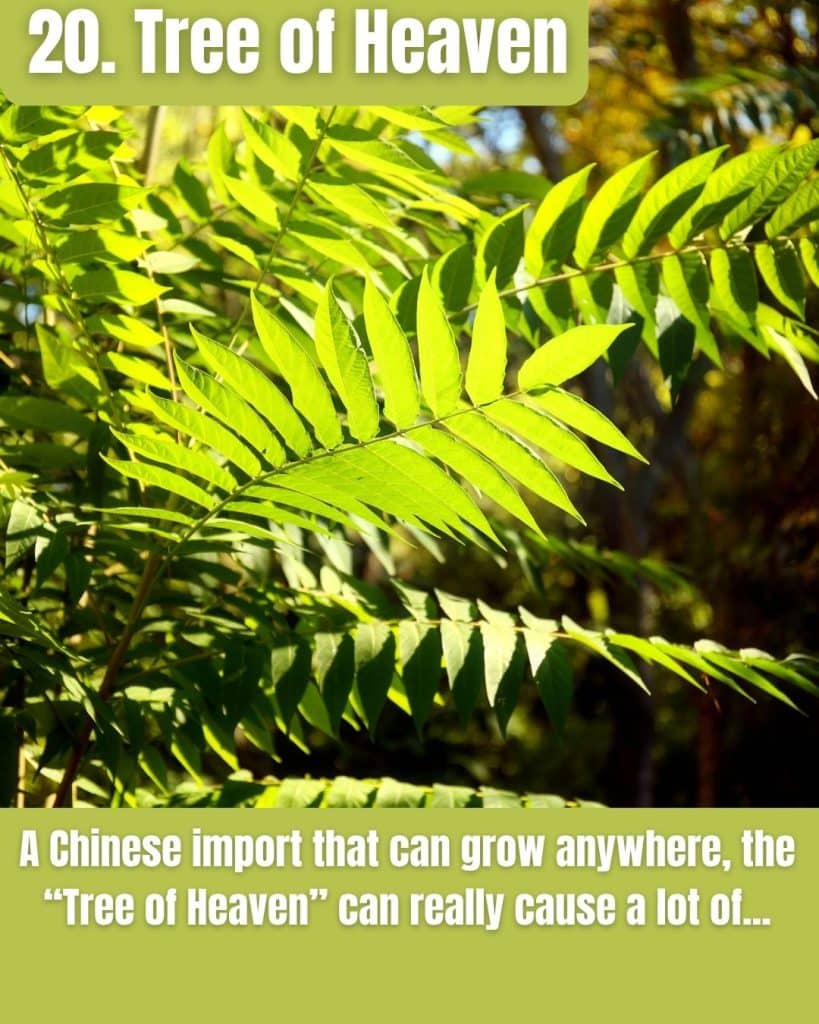
- Fast-growing tree that thrives in harsh urban and roadside environments.
- Produces many wind-dispersed seeds and releases soil toxins (allelopathy).
- Damages infrastructure with aggressive roots and hosts invasive insects.
Tree-of-heaven, native to China, is a notorious invasive in Tennessee’s cities and roadsides. Its rapid growth and chemical release prevent other plants from growing nearby, reducing native tree diversity.
It also harms sidewalks and foundations with aggressive roots. This tree hosts the spotted lanternfly, a potential agricultural pest.
Difficult to eradicate due to vigorous stump sprouting, it poses major challenges for land and city managers.
Insects
Emerald Ash Borer (Agrilus planipennis)
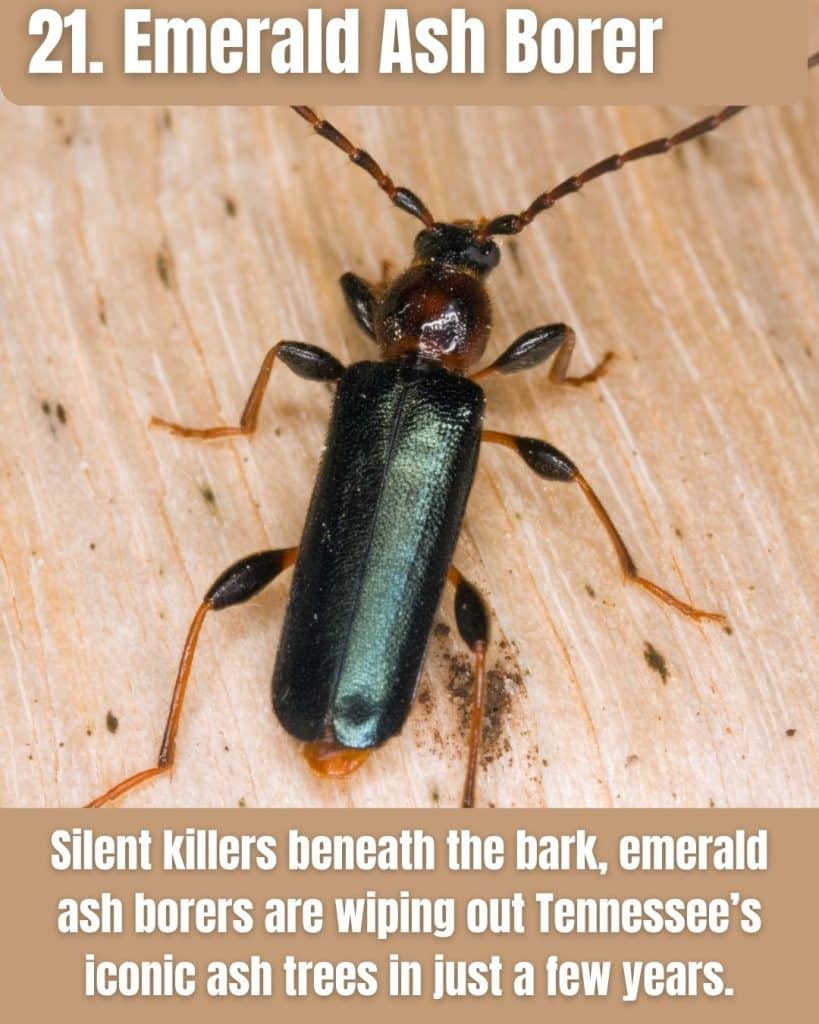
- Metallic-green beetle whose larvae kill ash trees by burrowing under bark.
- Causes widespread ash tree death, altering forests and wildlife habitats.
- Results in costly tree removal and timber industry losses.
The emerald ash borer, native to Asia, has devastated ash trees across Tennessee since its arrival in the early 2000s.
While adults cause little damage, their larvae girdle trees by feeding beneath the bark, killing them within years. This leads to loss of vital wildlife food sources and habitat cooling near streams.
Cities and timber industries face high costs for removal and replacement. Despite control efforts, EAB remains a top invasive threat in Tennessee.
Spongy Moth (Lymantria dispar)
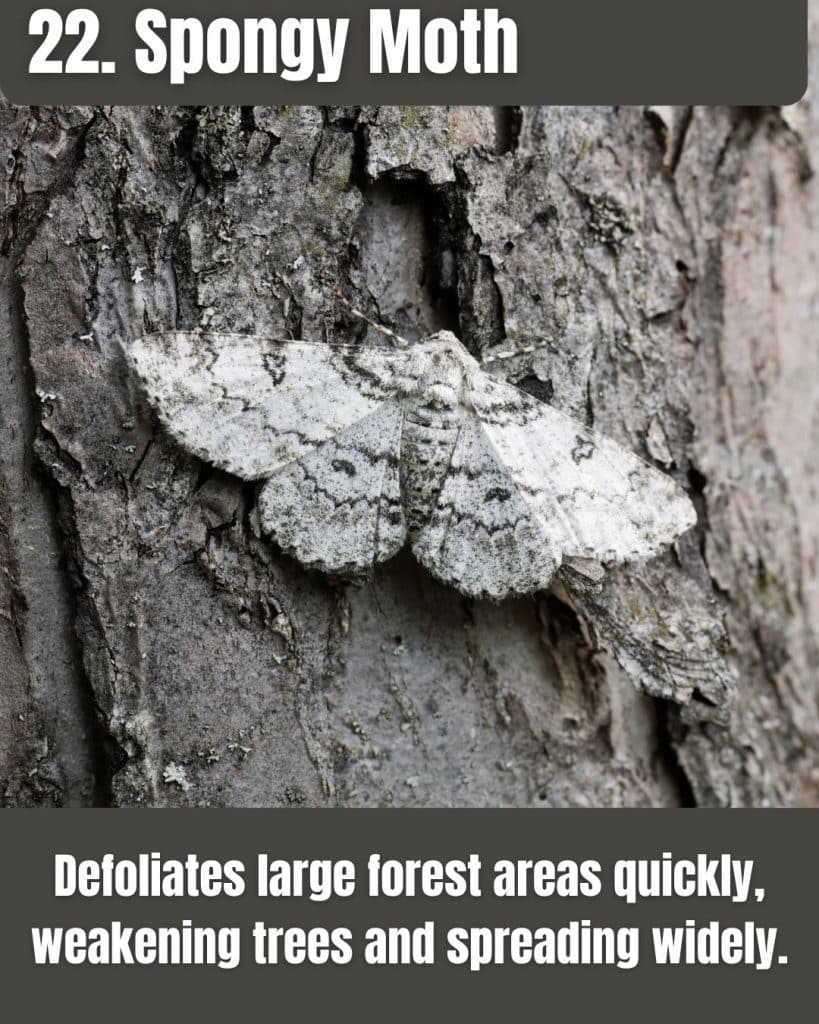
- Invasive caterpillar that defoliates hardwood trees, especially oaks.
- It can cause repeated tree damage, threatening Tennessee’s forests.
- Spreads easily by wind and human activity, making control difficult.
The spongy moth, introduced from Europe, is expanding into Tennessee’s hardwood forests. Its caterpillars can strip leaves from trees during population outbreaks, weakening or killing them over time.
This threatens oak-hickory forests and the wildlife depending on them. Outbreaks also impact people with crawling caterpillars and messy frass falling from trees.
Control involves monitoring and targeted pesticide spraying, but the moth’s ability to travel on wind or firewood makes it a persistent invasive threat.
Red Imported Fire Ant (Solenopsis invicta)
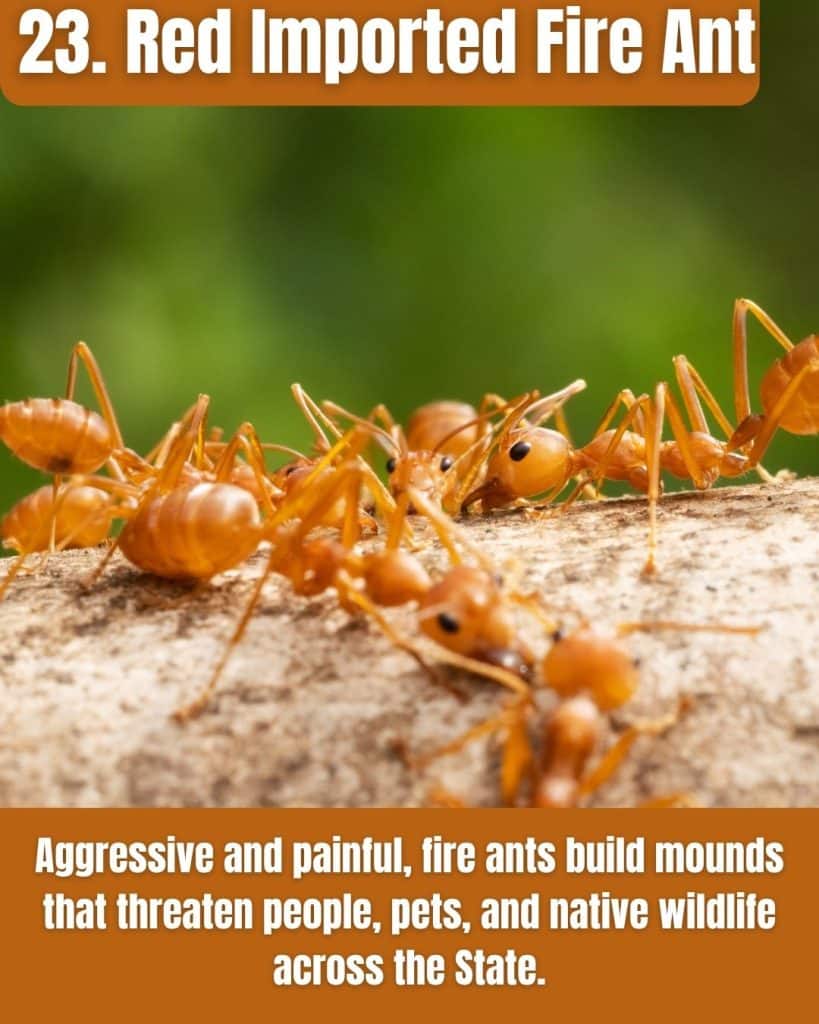
- Aggressive stinging ant known for painful bites and allergic reactions.
- Damages electrical equipment and disrupts outdoor activities.
- Preys on native insects and wildlife, disrupting ecosystems.
Red imported fire ants, native to South America, have spread across Tennessee, building large mounds in yards and fields.
Their stings can harm people, pets, and livestock. They damage irrigation systems and electrical boxes by chewing wires.
Ecologically, they reduce native insect populations and threaten ground-nesting wildlife. Managing these ants requires costly, ongoing treatments for homeowners and farmers.
Their aggressive behavior and broad impacts make them one of Tennessee’s worst invasive insect pests.
Hemlock Woolly Adelgid (Adelges tsugae)
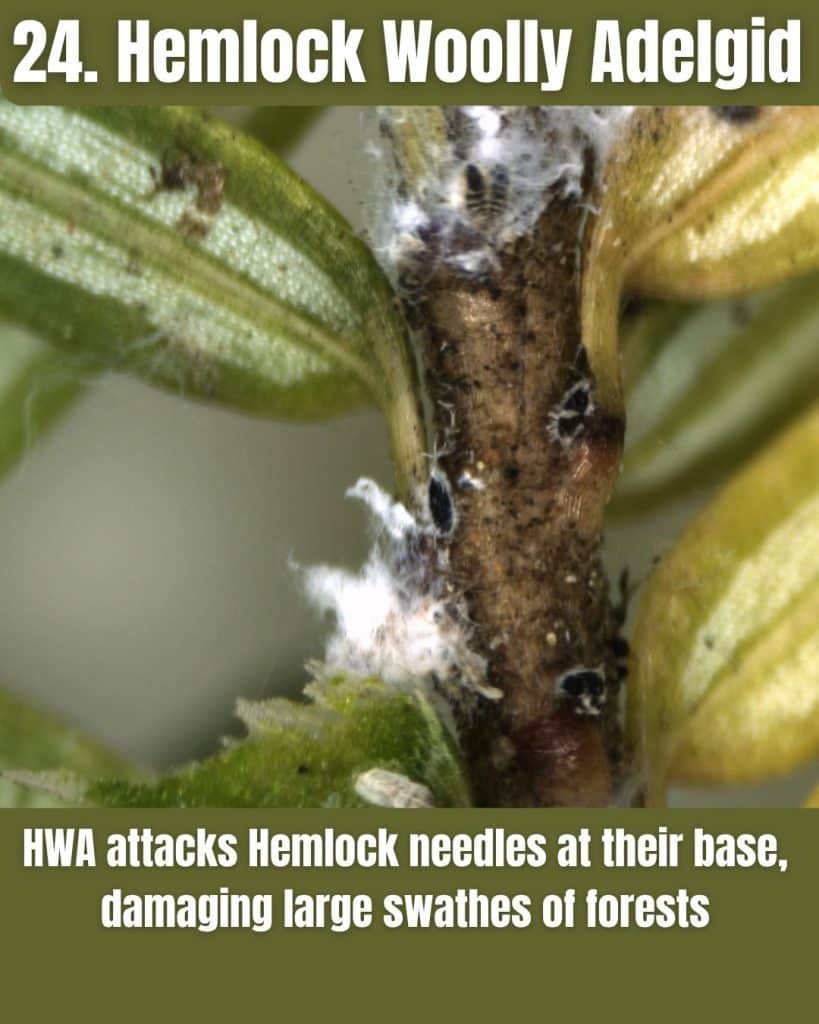
- Tiny insect that sucks sap from eastern hemlock needles.
- Causes widespread hemlock death, altering mountain stream ecosystems.
- Difficult to control despite biological and chemical treatments.
The hemlock woolly adelgid, native to Asia, reached Tennessee in the early 2000s and has devastated hemlock forests, especially in the Great Smoky Mountains and Cumberland Plateau.
It feeds at the base of needles, causing yellowing, needle drop, and branch dieback.
Hemlock loss warms streams, harms trout habitat, and disrupts forest ecosystems used by birds and mammals.
Dead trees also pose hazards and reduce scenic value. Control efforts include beetle releases and insecticides, but full protection is challenging due to terrain and scale.
Brown Marmorated Stink Bug (Halyomorpha halys)
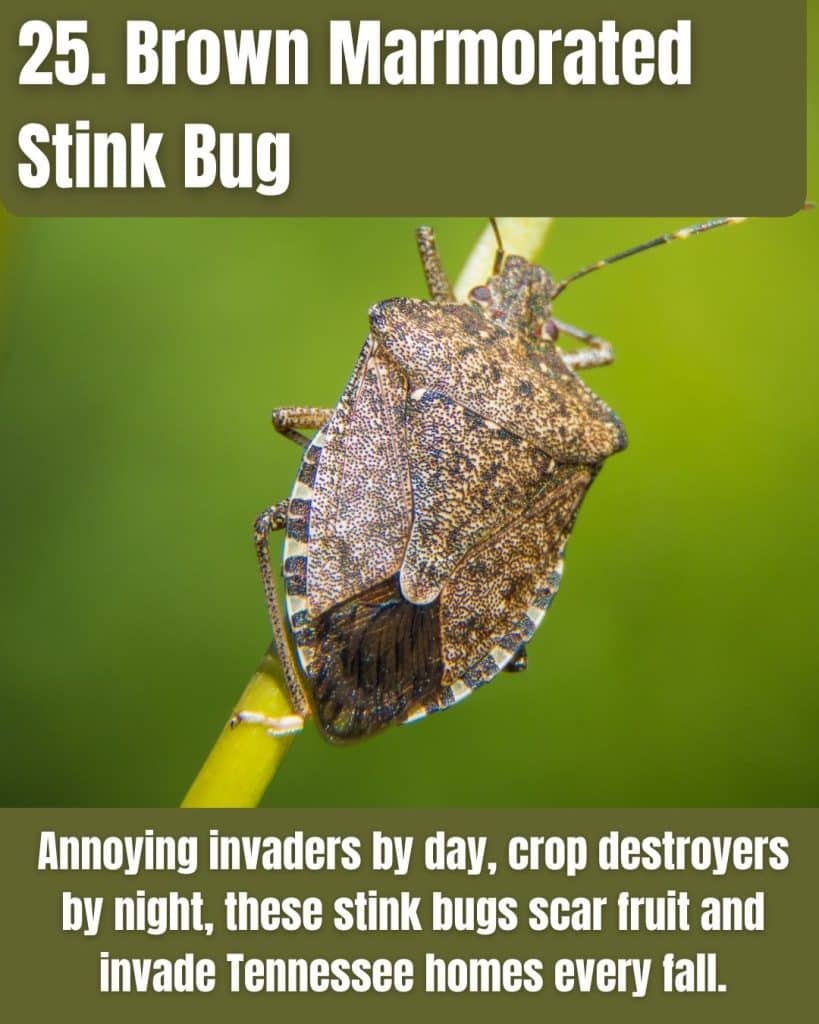
- Pierces and damages a wide range of crops, causing economic losses.
- Releases a foul odor when threatened or crushed.
- Invades homes in large numbers during fall as a nuisance pest.
The brown marmorated stink bug, native to East Asia, has spread across Tennessee since the 1990s.
It damages fruits, vegetables, and ornamental plants by feeding on them, leading to costly control efforts for farmers.
In the fall, these bugs seek shelter indoors, often invading homes and releasing their unpleasant smell when disturbed.
With few natural predators locally, their populations continue to grow, impacting both agriculture and homeowners.
Thanks for reading! We hope you enjoyed the article, and enjoy your day!